打破王室着装规则的戴安娜王妃
来源:BBC Learning English 作者:林赛·贝克(Lindsay Baker) 更新:2017年5月8日

从"害羞的戴"(Shy Di),到时髦自信的国际时尚明星,威尔士王妃戴安娜一生的后期是一场史诗般的旅程——更是一场服饰之旅。在她突然过世后的二十年里,戴安娜一直保持着时尚女神的地位。这充分说明了她强大的影响力。戴安娜年少天真时曾被时尚界斥为富家女。不过,在2017年,她成为了时尚界的典范。
为纪念戴安娜王妃不幸逝世20周年,肯辛顿宫(Kensington Palace)举行了戴安娜王妃时尚故事展(Diana: Her Fashion Story),探索她的时尚演进历程。虽然,戴安娜王妃常常被视作一名受害者,但是该展览所体现的却是一个意志坚定、积极追求事业和个人目标的独立女性。展出的服装体现了戴安娜在视觉表达方面的创新。她打破传统,将自己的叙事方式变成了自己的品牌。虽然戴安娜也有一段天真少女的日子——她曾经穿半透明的短裙拍过暴露的背光照——但是她后来学会了公开场合的着装规则。更重要的是,她学会了如何改变和打破这些规则。
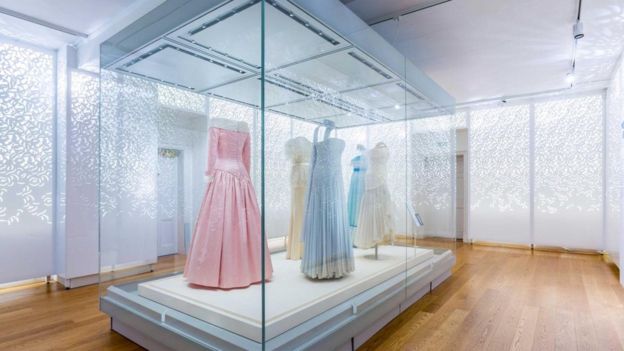
肯辛顿宫目前正在举行的展览探索了戴安娜的时尚演进历程(图片来源:Diana Her Fashion Story)
戴安娜在早期公众生活中穿的带波浪翻领的印花高腰牛仔裤和带猫咪领结的衬衫现在已经随处可见。服装品牌Asos最近的一个系列向戴安娜致敬,以珍珠滚边直筒连衣裙和富家女褶裥短裙为特色。包括影响力巨大的安德森(JW Anderson)等在内的很多设计师都曾经从戴妃的经典服饰吸取灵感,比如现在无处不在的波浪宽松袖。
那么为什么戴妃早期的服装会在当前引起共鸣呢?时尚具有循环的特点,所以各种潮流总会反复出现,本次展览的策展人埃勒瑞·林恩(Eleri Lynn)向BBC文化如是说。"威尔士王妃戴安娜当年不论穿什么,都会受人模仿,成为她的风格。她的文化影响力如此之大,以至于她穿上的伊曼纽尔粉色新浪漫主义衬衫立即被称为戴妃衬衫,这个叫法留传至今。"
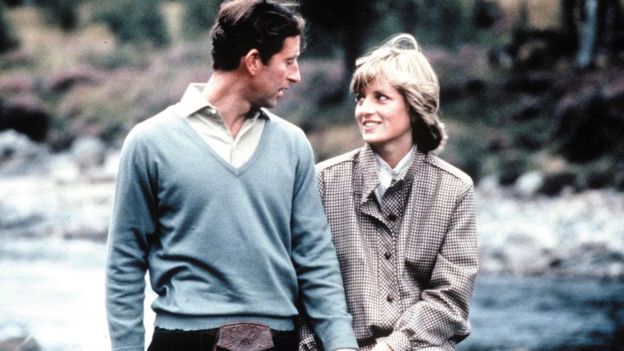
她蜜月时穿的粗花呢裙遵循了织物的规则,不过束腰夹克衫参考了当时的流行趋势(图片来源:Diana Her Fashion Story)
戴安娜并不是第一个引领潮流趋势的皇室人物。林恩解释道:"英国皇室早有时尚传统,大概可以上溯至几个世纪前,当时的上流社会会模仿皇室的风格。以玛格丽特公主(Princess Margaret)为例。她被认为是时尚潮人,媒体也常常报道她的穿着。我认为区别在于戴安娜·斯宾塞女士登上国际舞台之时,恰逢媒体本身的一场变革——大量新闻涌现,小报记者横行以及数字时代的来临——所以戴安娜的服装对公众流行趋势的影响比以往任何时候都更为直接。她很快就学会了如何利用自己的形象来传达信息和目标,帮助她完成手上的工作。"
本次展览探索了这一过程。"探究戴安娜在时尚方面的冒险非常有趣,"林恩说,"她学会了皇家不成文的着装规则,而有的时候她希望打破规则,甚至是略带一些大胆的修饰。她是第一位穿裤子出席晚会的皇室女性。她很喜欢穿男式无尾礼服和黑色衣服——而皇室成员通常只在哀悼时才穿黑色。
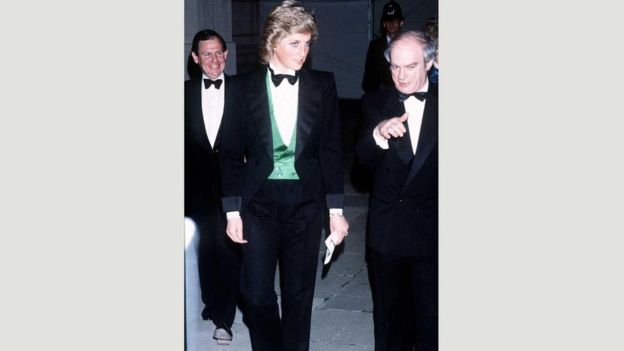
戴安娜穿男式无尾礼服和黑色衣服,对皇室传统的着装规则发起温和的挑战(图片来源:Alamy)
这是一种微妙的颠覆。她曾在巴尔莫勒尔堡(Balmoral)身穿比尔·帕什利(Bill Pashley)设计的粗花呢套装裙与威尔士王子查尔斯拍摄正式的蜜月照。虽然这遵守了皇室传统的织物着装规则,但是宽松的夹克巧妙的违反了规则。这种不正式的、流行的束腰款式参考了当前的风格并暗示了对含蓄、拘谨的皇家着装规则的背离。
林恩说:"在都铎王朝时期,显然要传达地位和威严的信息。现代皇室通过他们的服装来传达外交信息。戴安娜知道她需要达到的要求,并与设计师合作以"传达皇家的软实力外交,完成她的使命。"戴安娜的很多裙子是由她的长期合作凯瑟琳·沃克尔设计公司(Catherine Walker and Co)制作。沃克尔本人于2010年去世,而她的丈夫、公司合伙人赛勒斯·萨伊德(Cyrus Said)在切尔西(Chelsea)工作室继续为戴安娜服务。赛勒斯告诉BBC文化:"我们以皇家着装的源头为指导,比如"玛丽女王(Queen Mary)和亚历山大女王(Queen Alexandra)和她们的那个时代所体现出的典雅和奢华。"
打破禁忌
传统和历史当然重要,但是戴安娜和她的合作者继续通过一些小改变来向世界推广英国的时尚。到20世纪80年代中期,她进入了所谓的"戴妃王朝"时期,她的穿衣风格也越来越有魅力,采用更多的装饰,并加强肩部的剪影。其中一个突出的例子是1986年她穿的由凯瑟琳·沃克尔设计的绿色亮片宽肩晚礼服。沃克尔称之为"尊贵的震撼之作"。策展人林恩说:"她享受通过裙子表达个性的过程,把个性融入服装,表达她对乐趣的看法——比如穿戴不搭配的饰品或通过服饰发出大胆宣言。设计师大卫·沙宣(David Sassoon)回忆说,她在试衣服时常常会流露出开玩笑的眼神,并评价道:'啊,他们会喜欢这个的!'"
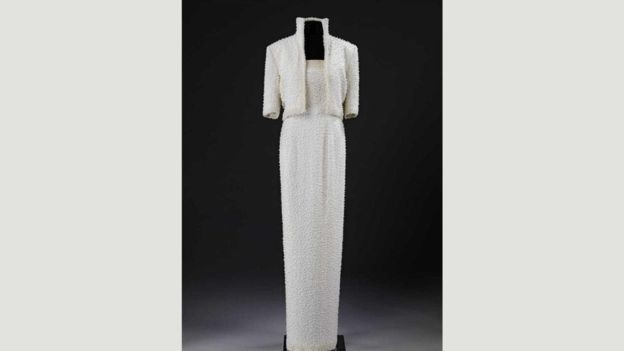
凯瑟琳·沃克尔设计的猫王裙是戴安娜在80年代中期闪耀、时髦风格的一个例子(图片来源:Diana Her Fashion Story)
戴安娜在1989年所穿的所谓的"猫王裙"甚至更为大胆和闪亮,那是凯瑟琳·沃克尔的又一件作品。无吊带白色真丝裙搭一身闪闪发光的立领夹克,并配以闪光亮片和珍珠刺绣,极其夸张。赛勒斯·萨伊德说,为戴安娜设计服装每次都是"一场密切的合作。一件漂亮的裙子本身就是一件美丽的事物——是女性和裙子之间的融合或张力。设计师应扮演支持者的角色,为她提供所需工具,完成设计工作。这关系到女性和裙子的统一,这就是我们的操作方式。"
戴安娜在80年代中期的打扮非常有魅力,有些时候甚至过分——并且完全是一时兴起。"这种打扮当时非常流行。"策展人林恩说,"它反映了女强人式着装盛极一时。当时,很多女性进入董事会,所以要通过这种服装来显示权威。事实上,你会发现从那时起,她就逐渐远离时尚界的季节性变化,形成了一种更为恒久的穿衣风格。此时,她开始相信自己对风格的理解,并知道什么会适合自己。"戴安娜人生故事中的另一个关键时刻是1985年她在白宫的国宴上穿维克多·埃德尔斯坦(Victor Edelstein)设计的一袭午夜蓝天鹅绒晚礼服裙,与约翰·特拉沃尔塔(John Travolta)翩翩起舞。全球的电视屏幕和新闻上充斥着这两人在舞池优雅的身姿。这是魅力、自信和独立的大胆——同时隐含标新立异的——宣言。
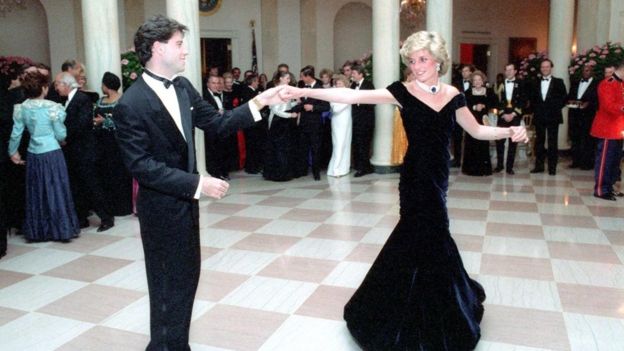
1985年,穿一袭维克多·埃德尔斯坦设计的天鹅绒裙与约翰·特拉沃尔塔跳舞,成为魅力和独立的大胆宣言(图片来源:Alamy)
后来,戴安娜与查尔斯王子离婚,并放弃了自己的殿下头衔。此后,她得到了更多的自由,可以尝试和非英国籍设计师合作。比如,1991年帕特里克·德马舍利耶(Patrick Demarchelier)为她拍摄了哈波(Harper)的《时尚芭莎》(Bazzar)封面照,她当时身穿时髦的冰蓝色范思哲礼服。
在这个阶段,她回归自我,变得非常时尚、优雅,并明确人生的重点。她重新塑造了自己的公众形象,在很多慈善事业和人道主义事业方面取得成功。"她说自己不想做爱打扮的人,想做一番事业,"林恩说,"她简化了自己的形象,让媒体把注意力从她的打扮转移至她从事的工作。"直筒连身裙、简单的套装裙和经典的白色衬衫和斜纹布裤的搭配(她在地雷慈善旅行时这样穿)传达出一种明快的职业感。1997年,戴安娜捐出了79件她珍爱的裙子,在纽约的佳士得拍卖会上为癌症和艾滋病慈善机构筹得340万英镑的巨款。正如赛勒斯所说:"她的遗产是她利用自己的地位拯救生命。"
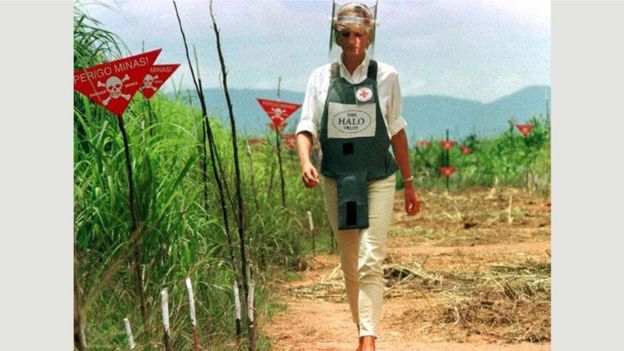
戴安娜身着经典的白色衬衫和斜纹布裤参与地雷慈善之旅,显示出她的职业感(图片来源:Alamy)
"她对公众对艾滋病的看法产生了深远的影响,"林恩说,"她几乎不戴手套。只在一次著名的仪式上,她戴了手套,不过她非常明显的脱下手套和艾滋病人握手,打破了围绕这种疾病的禁忌。她利用裙子来真正的说明自己的观点。在正式活动中,戴安娜会仔细考虑她要会见的对象,并思考自己应留给他人的印象。"
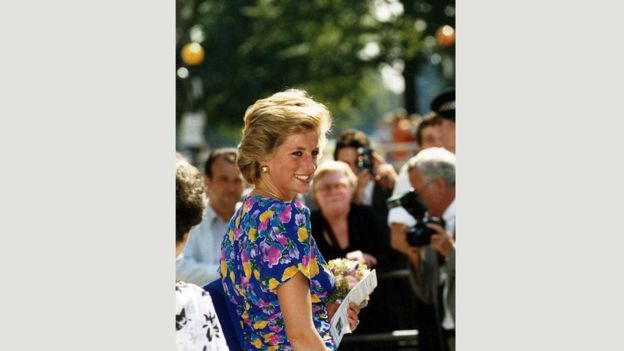
大卫·沙宣1988年的印花蓝裙子被王妃命名为她的"关爱"裙,因为孩子们喜欢这条裙子(图片来源:Alamy)
"当她前往儿童医院时,她身穿活泼的、不太正式的衣服。这样打扮是为了传达平易近人和温暖的信息,以加强非正式感。大卫·沙宣1988年的印花蓝裙子被王妃命名为她的'关爱'裙,因为孩子们喜欢这条裙子。大卫的草图里有一顶帽子,但是她没有订购,如她所说'你没法戴帽子拥抱孩子。'在人道主义事业方面,她取得了巨大的成功,她的遗产留在她所触及的人的生命中。"虽然她是一个无可争议的时尚名人,但是很可能她给人印象更深的是她的波浪翻领或闪亮的晚礼服。
How Diana broke the rules
From mousy ‘Shy Di’ in puff-sleeved pastels to chic, sleek, internationally renowned fashion star, the life of the late Diana, Princess of Wales was an epic journey – sartorially, and in every sense. And the fact that Diana retains her style-muse status – two decades on from her shocking death – speaks volumes about the powerful impact she made. Her early unsophisticated look, previously dismissed in fashion circles as ‘Sloaney’ and uncool, has become the epitome of fashion in 2017.
Marking the 20-yearanniversary of her tragic death, Diana’s style evolution is explored in the exhibition Diana: Her Fashion Story at Kensington Palace. Although Diana has frequently been cast as a victim, what emerges from the exhibition is the sense that she was a strong-minded, independent woman, one who actively championed her chosen causes and personal goals. The collection of outfits on display explores Diana as an innovator in visual messaging, a disrupter of convention, and a pioneer in the way she turned her own narrative into her brand. After those early, guileless Lady Di days – including the famously revealing backlit photograph in a semi-transparent skirt – she learned the rules of public dressing and, significantly, learned how to bend and break those rules.
The floral prints, pie-crust collars, high-waisted jeans and pussy-bow blouses that Diana sported in the early days of her public life are now everywhere in fashion. A recent collection for Asos was a direct homage, featuring pearl-trim shift dresses and Sloaney kilts; many designers, including the influential JW Anderson, have drawn on classic Di trademarks such as the currently ubiquitous voluminous, billowing sleeves.
She quietly signaled a departure from the famously buttoned-up, rigid royal codes
So why has the early-Di look struck such a chord now? “Fashion is cyclical, and so various trends will always make a re-appearance,” Eleri Lynn, curator of the exhibition, tells BBC Culture. “Diana, Princess of Wales’s power was that when she wore something, the look was so copied and so emulated that it became almost definitively hers, such was her cultural impact – the pink Emanuel ‘New Romantic’ style blouse she wore was immediately dubbed the ‘Lady Di Blouse’, and is still known that way.”
Not that Diana was the first royal to set trends. As Lynn explains: “The Royal Family has a long tradition of being fashionable, dating back centuries probably, as high-society sought to emulate their style. Princess Margaret, for example, was regarded as highly fashionable and the press reported often on her wardrobe. I think the difference is that Lady Diana Spencer stepped on to the international stage at a time when the media itself was changing – with rolling news, tabloid journalism, and the dawn of the digital age – and so the effect of Diana’s wardrobe on wider public trends was much more immediate than ever before. She quickly learned how to use her image to communicate her messages and goals however, and to help her to do the job at hand.”
The exhibition explores this process. “It’s been fascinating to look at some of the risks Diana took with fashion,” says Lynn. “She learned the unwritten rules of royal dressing, and she liked to break them sometimes, even with tiny touches of something daring. She was the first female royal to wear trousers to an evening event. She liked to wear tuxedo-style outfits and she wore a lot of black – a colour usually only worn by the royal family for mourning.”
It was a subtle kind of subversion. A Bill Pashley tweed skirt suit worn for the official honeymoon photograph with Charles, Prince of Wales, at Balmoral adhered to the traditional royal country-dressing rules in the fabric, while also cleverly bending those rules in the voluminous shape of the jacket. The informal, on-trend blouson shape referenced a more current style and quietly signalled a departure from the famously buttoned-up, rigid royal codes.
“In the Tudor period the message was clearly to project status and majesty,” says Lynn. “The modern Royal Family project diplomatic messages with their clothes.” Diana knew what was required of her, and collaborated with designers “to communicate the regal, soft-power diplomacy that was part of her job.” Many of Diana’s dresses were created by Catherine Walker and Co, her most long-standing designer. Walker herself died in 2010, and the Chelsea atelier continues under her business partner and now widower, Cyrus Said, who tells BBC Culture: “We were guided by the origins of royal dressing. Queen Mary and Queen Alexandra and their era which exuded elegance and luxury.”
Breaking taboos
Tradition and history certainly mattered, but Diana and her collaborators continued to add twists and tweaks, promoting British fashion worldwide in the process. She dressed in an increasingly ‘glamazonian’ style as she entered the so-called ‘Dynasty Di’ phase of the mid-1980s, adopting more embellishments and strong-shouldered silhouettes. The green sequinned, wide-shouldered evening gown by Catherine Walker that she wore in 1986 is a standout example of, as Walker herself had put it, a “dignified showstopper”. Curator Lynn says: “She certainly enjoyed expressing her personality through her dress, and playfully added personal touches to her look that conveyed her own sense of fun – such as wearing mismatched accessories or bold statement pieces. The designer David Sassoon recalls that she often had a playful glint in her eye when trying clothes on, and remarking: ‘Oh, they’re going to love this!’”
The so-called ‘Elvis dress’ that Diana wore in 1989 was even more daring and glitzy, and another Catherine Walker creation. A strapless white silk-crepe number teamed with a shimmering stand-up collared jacket, embroidered with luminous sequins and pearls, it was fabulously over the top. Cyrus Said says that the design process with Diana was always “an intimate collaboration. A beautiful dress is not per se a thing of beauty – it’s a combination of or a tension between the woman and the dress. The designer should be in the supporting role, giving her the tools she needs to get the job done. It’s about the union of the woman and the dress, which is how we operate.”
She said she wanted to be a work-horse, not a clothes-horse – Eleri Lynn
Diana’s mid-’80s look was glamorous, at times excessive – and completely of the moment. “The [Dynasty] look was very popular,” says curator Lynn, “It reflected the power dressing that was fashionable at the time, when women were seen to be stepping into the boardroom and using power suits to project authority. And you actually start to see her move away from the seasonal changes in fashion from this point onwards, to develop more of a timeless look. This is when she started to have confidence in her own sense of style, and in what suited her.” The sweeping Victor Edelstein midnight-blue velvet evening dress, worn at a state dinner at the White House in 1985 when the princess famously danced with Hollywood star John Travolta, was another key moment in Diana’s story. Images of the pair gliding gracefully around the dancefloor filled TV screens and newspapers across the globe. It was a bold – subtly maverick – message of glamour, confidence and independence.
Following Diana’s separation from Prince Charles and having dropped the HRH in her title, she had more freedom to experiment with some non-British designers, for instance with the sleek, ice-blue beaded Versace gown that she wore for a Harper’s Bazaar cover shoot with photographer Patrick Demarchelier in 1991. She appeared in this phase of her life to come into her own, and seemed at her most slick, elegant and focussed. She forged her new public role, championing a number of charitable and humanitarian causes. “She said she wanted to be a work-horse, not a clothes-horse,” says Lynn, “and simplified her look in order to focus the press attention on her work not her wardrobe.” The shift dresses, simple skirt suits and the classic white shirt-and-chinos combination (which she wore for her landmine charity trips) conveyed a brisk professionalism. And in 1997 Diana donated 79 of her most lavish dresses for auction at Christie’s in New York, raising a hefty £3.4 million for cancer and HIV charities. As Said Cyrus puts it: “Her legacy was the way she used her position to help save lives.”
“She had a lasting impact on the way the public perceived those suffering from Aids and HIV,” Lynn says. “She hardly ever wore gloves, but on one famous occasion when she did, she very conspicuously removed them to hold hands with an Aids patient, breaking the taboo surrounding the disease. [She was] using dress to really hammer home her point. On official engagements, Diana thought really carefully about who she was meeting and how she would be perceived.
“She dressed to communicate approachability and warmth – to encourage informality – as she did by wearing cheerful, less formal clothing to children’s hospitals. David Sassoon’s 1988 blue dress with printed flowers was named by the princess her ‘caring’ dress because children loved it. David sketched it with a hat but she never ordered it as she said ‘you can’t cuddle a child in a hat’. Her legacy was in the humanitarian causes she championed and in the people whose lives she touched.” Undisputed fashion icon though she was, Diana is likely to be remembered for much more than her pie-crust collars or her shimmering gowns.